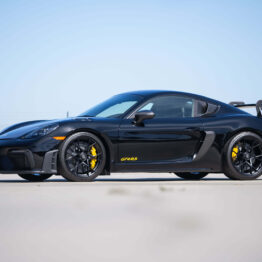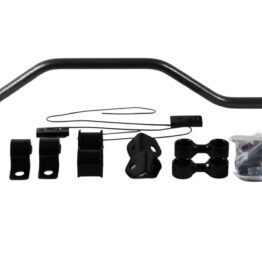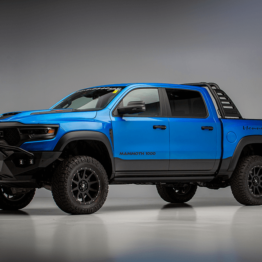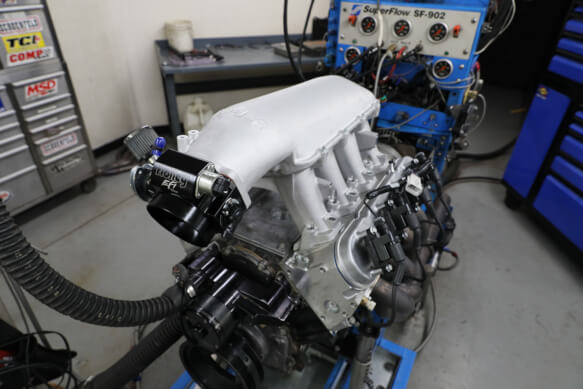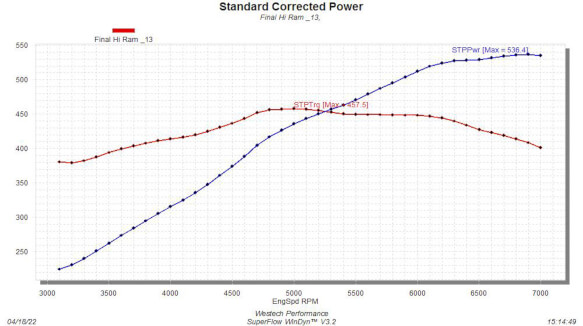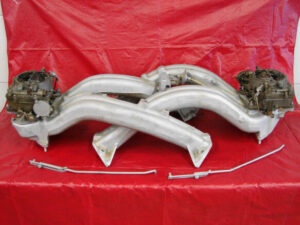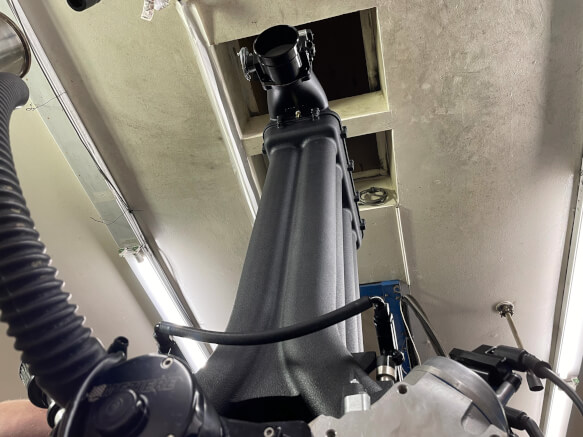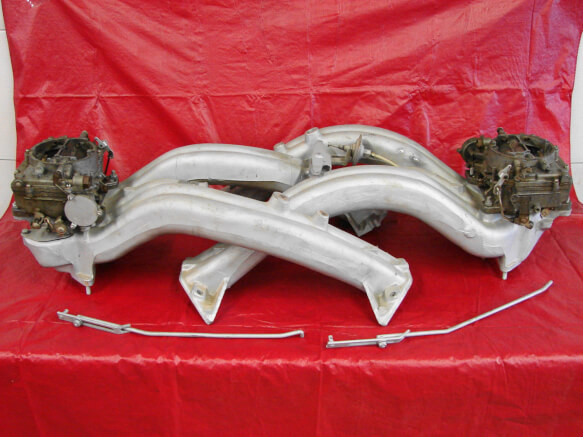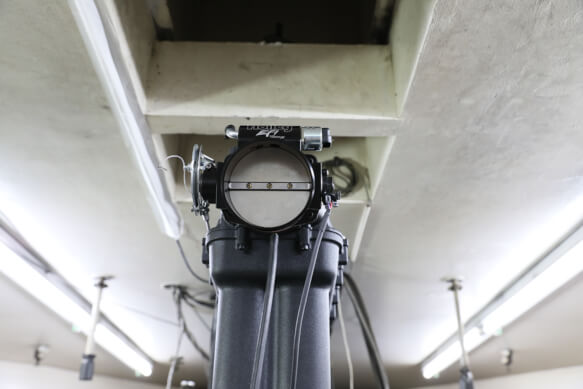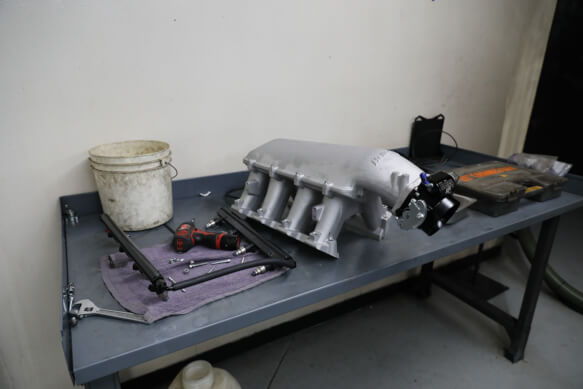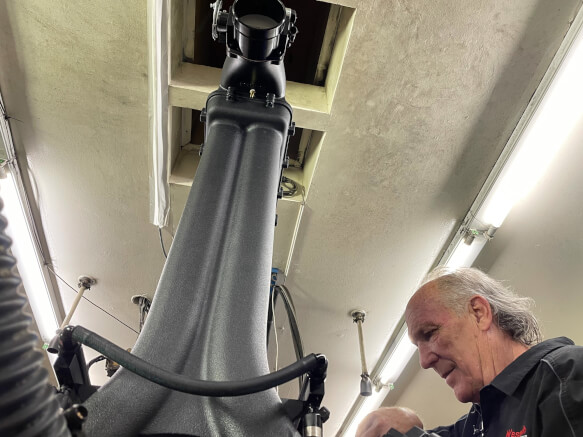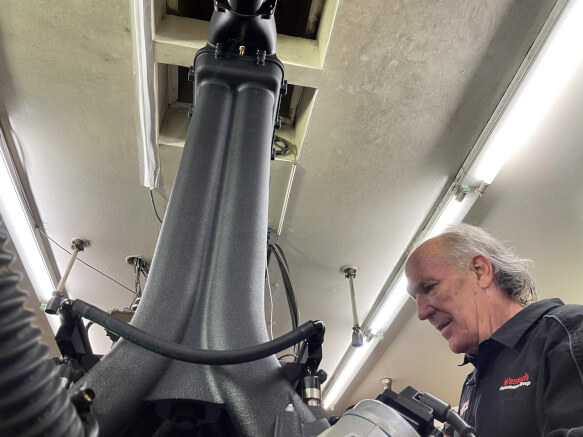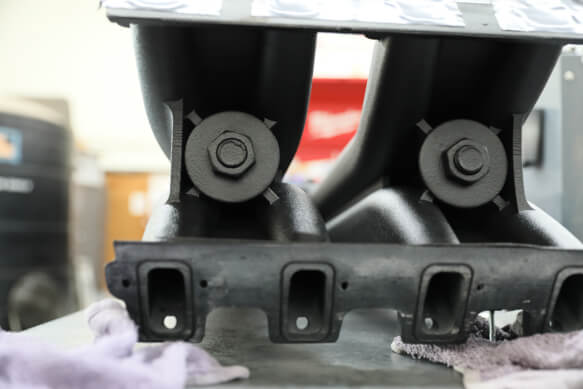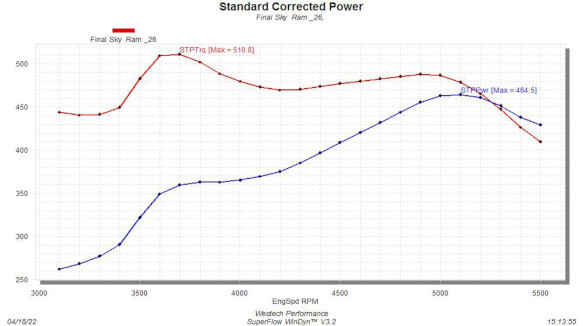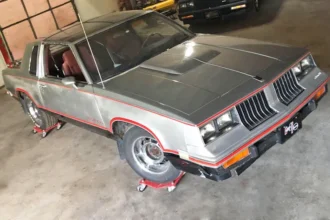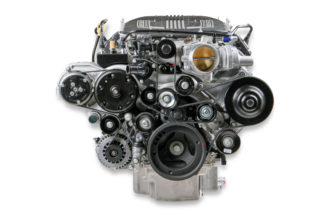photos/text by: Evan Perkins/Holley Performance
What started as an April Fools joke has morphed into a real-deal dyno test. The Sky-Ram, a lighthearted, thoroughly lengthened iteration of the popular Hi-Ram intake manifold, features a similar plenum and runner cross-sectional area, only with radically longer, 31-inch runners.
Dating back to the early ‘60s, several automotive companies tried their hands at long runner intakes in an effort to boost the low end torque available in their larger, heavier vehicle models. The most notable effort was Chrysler’s long ram which featured–oddly enough–31-ish inch runners. The result was an engine that delivered exactly as promised; significant low end torque improvements. However, the lengthy span from the cylinder head to the carburetor resulted in difficult cold start conditions and a myriad of other drivability issues, ultimately leading to its discontinuation.
Now, some 60 years later, we found ourselves in Westech’s dyno cell, looking for torque in all the same places. Would the skyscraper-esque runners of the Sky-Ram deliver a massive boost in torque? Would there be a herculean horsepower boost? We were about to find out.
A lot has changed since the ‘60s and the Sky Ram–all comedy aside–is a true testament to that. Where the original Long Rams were cast from aluminum in a labor-intensive process, the Sky-Ram was rapid prototyped from plastic that was 3D printed in Holley’s engineering lab. While 3D printing is nothing new to this generation of hot-rodders, can you imagine the look of surprise and disbelief a mid-‘60s engineer would’ve had at the notion?
The Sky-Ram also utilizes Holley EFI with modern port injection, making it extremely tunable, apathetic of any carburetor signal issues, and devoid of any hard starting troubles that might have plagued long-runner manifolds of yore.
The Test
Rather than run the Sky-Ram singularly, it was decided to compare it to the ever-popular Holley Hi-Ram. The Hi-Ram would provide a real-world baseline that the Sky-Ram could be compared against.
The engine used for the test was an LQ9, 6.0L LS-based mill, topped with Engine Quest LS3 style heads and upgraded with a COMP hydraulic roller camshaft. Cam specs landed at 227/243 degrees of duration with .613in/.623in of lift. The compression ratio was a pump-gas friendly 9.8:1.
A Holley EFI 105mm cable-actuated throttle body and front feed plenum were used on both intake tests. Air fuel mixture and timing were controlled by a Holley HP ECU, and standard Holley fuel rails with 32 lb-hr injectors fed each cylinder.
With the Hi-Ram bolted in place, Westech’s Steve Brulé fired the engine to life. After a few pulls to put some heat in the coolant and engine oil, Brulé yanked back on the throttle lever and let the engine sing against the dyno brake. The result was a very respectable 536 horsepower at 6,900rpm and 457 lb-ft of torque at 5,000rpm. The combo worked great with 380 lb-ft on tap as early 3,000rpm and an ample power curve that was almost flat from 6,400rpm to 7,000rpm. This was a powerplant that would be at home in any hot rod or racecar.
With the baseline established, it was time to see how adding gobs of runner length would transform the power and torque curves. There was speculation galore, and a giddiness percolating the dyno cell. Even Brulé, who’s tested about every intake manifold combo under the sun, hadn’t yet tested anything this… weird.
The Sky-Ram was bolted in place on the engine, needing only a lengthened harness connection to throttle position sensor (TPS) since an idle air control (IAC) wasn’t necessary on the dyno. With the base of the intake modeled after a Hi-Ram, it installed in the same manner, requiring no specialty hardware. The front-feed plenum up top is a Holley stocking part (300-246) and the same design used on the Hi-Ram. It was a true, apples to apples test.
It was all smiles when the Sky-Ram equipped LS barked to life. It ran, and that checked one box off the list. Brulé put the engine through a series of partial dyno pulls, dialing in the fuel mixture in the Holley HP ECU. The Sky-Ram was truly a different animal and warranted significant changes in the fuel tuneup from the previous Hi-Ram test.
Once satisfied the engine had the fuel it demanded, Brulé queued up the dyno one more time. The moment of truth had arrived.
The Sky-Ram-equipped LS hunkered down against the dyno as Brulé put it through its paces. An audibly different tone bellowed from the cell as the engine churned out 510.8 lb-ft of torque at a mere 3,700rpm, a 53.8 lb-ft improvement in peak torque over the Hi-Ram and 108 lb-ft improvement at the same, 3,700rpm. Power climbed rapidly, boasting a significant 70 horsepower over the Hi-Ram at 3,600rpm. Soon, however the Sky-Ram’s early horsepower lead trailed off and it began to show its hand, the inevitable downside to the ultra-long-runner design.
Peak horsepower, 464.5, occurred at 5,100rpm and soon after it ran head-first into a wall. The airflow capability of the runners pegged and power fell off rapidly. Brulé ended the pull at 5,500rpm. While the Sky-Ram rewarded with massive torque gains and a robust power curve, it was down a whopping 71.9 peak horsepower from the tried and true Hi-Ram combination.
Runner Length Explained
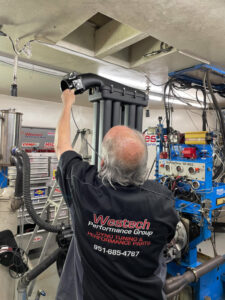
Dyno operator and Engine Masters star, Steve Brulé, stands nearly on tip toes to reach the TPS connector on the Sky-Ram.
At this point you may be asking. “Why does runner length affect the powerband?” To answer this question and deliver some context to our test results, we must first define runner length. In internal combustion engines, runner length is considered the distance from the intake port to the source of air entering all cylinders of the engine. On this LS, each cylinder shares a common plenum in the intake manifold, so we will define the runner as the distance from the intake port to the plenum.
As an engine operates, pistons move downward in their bores as the intake valves open. This draws in a mixture of air and fuel and creates a moment of low pressure in the runner. As the piston begins the compression stroke, the intake valve closes, and the volume of high-speed air in the runner that the cylinder didn’t ingest that cycle slams into the back of the closed valve face, creating a high pressure wave. This high-pressure wave of air reflects backward up the runner and subsequently back down the port.
These pressure waves endlessly bounce up and down the runner until a point occurs at a specific engine speed where that high pressure air wave synchronizes with the opening of the intake valve. This serendipitous occurrence provides a boost of cylinder filling that helps the engine operate with increased volumetric efficiency, the ratio of the physical displacement of the engine to the amount of air/charge it is actually ingesting. For example, a 350ci engine operating at 100% volumetric efficiency (VE) would ingest 350ci of air per cycle. On well-tuned high-performance engines, it is possible to see VE numbers above 100%.
By manipulating the runner length (as well as countless other variables) engineers are able to alter the point in the powerband where that wave aligns with the intake valve opening and hence where the engine will perform most efficiently. Longer runners tend to fix this point at lower engine speeds, while shorter runners push it toward higher engine speeds.
The Takeaway
So there you have it, folks. Long intake runners certainly deliver on their promise of increased low-end torque. In fact, the Sky-Ram intake would be a lot of fun in a hot rod. That tire-shredding torque would make for both smiles and smoky burnouts, assuming you don’t mind peeling back the sheet metal of your hood to fit it. However, this exercise in theory and lighthearted fun is not intended for production. For the rest of LS enthusiasts out there–the horsepower obsessed, and time-slip oriented kind–the Hi-Ram remains the better path to power.

AutoCentric Media is the fastest-growing all-encompassing digital magazine, catered to automotive enthusiasts from all walks of life, with various interests.

